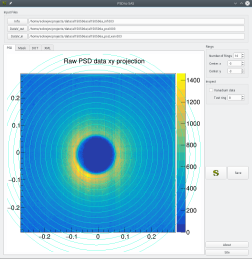|
|
|

|
PROGRAM LIBRARY JINRLIBPSD2SAS - Data converter for position-sensitive detector of small-angle neutron scattering spectrometer in isotropic pattern scattering caseAuthors: A.G.Soloviev, S.A.Kutuzov, O.I.Ivankov, A.I.Kuklin |
|
|
|
|
Environment: ROOT-based Qt Application The modern trends in use of the small-angle scattering method consist in varying a sample environment, e.g. temperature, pressure, magnetic or electric fields. The objects under investigation can be oriented in the field or by the flow of a liquid. In this case the need for the position-sensitive detector (PSD) arises. The position-sensitive detector of the new type has been created for the YuMO spectrometer [1]. Currently, this spectrometer has a two-detector system with coaxial ring detectors with a central hole and does not have azimutal angle sensitivity. And the SAS package [2] is used for its data treatment. PSD is planed to be mount either in the place of one of YuMO detectors, or in addition to them (turning it into three-detector system). And the problem of PSD data processing is actual. Due to small size of PSD cells statistics in them is often poor. That fact negatively impacts on data treatment. On the other hand, in most of the experiments one needs isotropic pattern of scattering only, when objects in a sample are not oriented. Thus in most cases is possible to combine PSD cells into concentric rings what first improves statistics and finally makes applicable the algorithms already used for data processing in SAS. Downloads: https://gitlab-hybrilit.jinr.ru/yumo-updates/psd2sas



|
|



